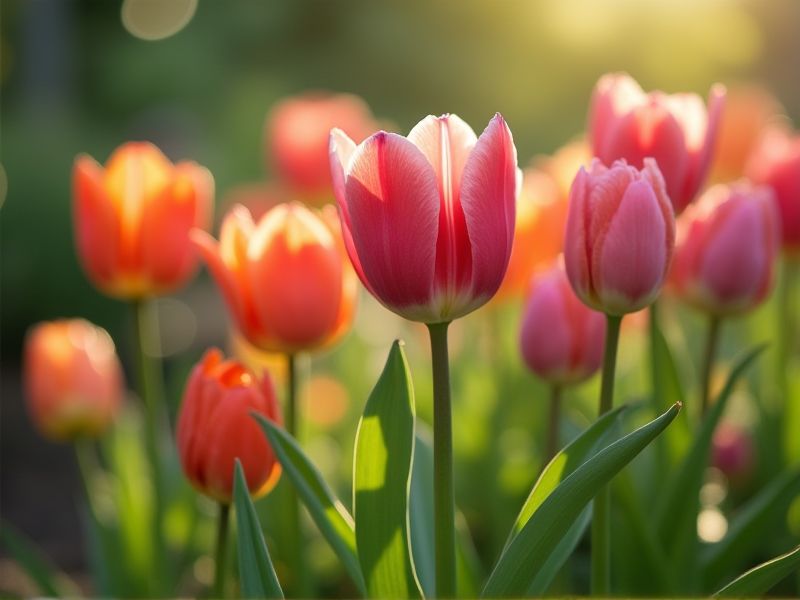
Bulbous plants, characterized by their underground storage organs known as bulbs, include species like tulips, daffodils, and onions. These plants thrive in diverse climates, showcasing their vibrant flowers during springtime when temperatures rise. Bulbs serve as vital energy reserves, allowing them to survive periods of dormancy in unfavorable conditions. When planting bulbs, ensure the soil is well-drained and rich in organic matter to promote healthy growth. You can enjoy a stunning garden display by selecting a variety of bulbous plants that bloom at different times throughout the season.
List of some Bulbous plants that grow from bulbs
- Tulip (Tulipa)
- Daffodil (Narcissus)
- Hyacinth (Hyacinthus)
- Lily (Lilium)
- Allium (Allium)
- Snowdrop (Galanthus)
- Crocus (Crocus)
- Amaryllis (Hippeastrum)
- Bluebell (Hyacinthoides)
- Dutch Iris (Iris hollandica)
Important things about Bulbous plants that grow from bulbs
Bulb Structure And Function
Bulbous plants, such as tulips and daffodils, develop from specialized underground storage organs called bulbs, which consist of layers of fleshy scales filled with nutrients. These bulbs serve as a survival mechanism, allowing the plants to endure adverse conditions like drought or frost by storing energy and moisture. The outer protective tunic shields the inner layers, ensuring that the developing shoots and roots can efficiently emerge during the growing season. Understanding the bulb structure and function can help you cultivate these resilient plants in your garden, ensuring vibrant blooms each spring.
Types Of Bulbous Plants
Bulbous plants, characterized by their underground storage organs, primarily thrive from bulbs that serve as reservoirs of energy and nutrients. Examples include Tulips, Daffodils, and Hyacinths, which burst into vibrant blooms each spring. These plants often require well-drained soil and can be found in a variety of garden settings, enhancing color and texture in landscapes. You can cultivate these hardy perennials in your own garden, allowing them to multiply and return year after year, creating a stunning display of flowers.
Growth Cycle Of Bulbs
Bulbous plants, such as tulips, daffodils, and lilies, undergo a distinct growth cycle characterized by distinct stages. Initially, during the dormant phase, the bulb stores energy and nutrients, preparing for the upcoming growth season. As temperatures rise in spring, bulbs absorb moisture and nutrients from the soil, leading to the emergence of shoots and leaves. This is followed by the flowering stage, where vibrant blooms emerge, attracting pollinators and facilitating reproduction, before the plant enters dormancy again as summer approaches.
Ideal Soil Conditions
Bulbous plants thrive best in well-draining soil enriched with organic matter, which helps retain moisture while preventing root rot. The optimal pH level for these plants typically ranges between 6.0 and 7.0, promoting healthy growth and vibrant blooms. Incorporating compost or well-rotted manure can enhance nutrient availability, supporting robust bulb development. Lastly, ensuring adequate sunlight exposure and spacing between bulbs will maximize their growth potential and flowering quality.
Watering Requirements
Bulbous plants, such as tulips, daffodils, and lilies, thrive with careful attention to their watering requirements. These plants store moisture in their bulbs, so it's essential to allow the soil to dry out between waterings, often requiring irrigation every 1-2 weeks depending on climate and soil type. Overwatering can lead to bulb rot, while underwatering may stunt their growth or prevent flowering. When cultivating bulbous plants, ensure that the planting medium provides good drainage to promote a healthy root system and vibrant blooms.
Sunlight Preferences
Bulbous plants, such as tulips and daffodils, thrive best in full sunlight, which encourages robust growth and vibrant blooms. Ideally, they should receive at least six hours of direct sunlight daily, enhancing their ability to photosynthesize and store energy in the bulbs. Your garden's location should be strategically chosen to avoid shaded areas, ensuring these plants can maximize their exposure during the growing season. Proper sunlight exposure not only improves flower quality but also promotes healthier foliage and increases the likelihood of blooming year after year.
Fertilization Methods
Bulbous plants, such as tulips, daffodils, and hyacinths, thrive when properly fertilized, enhancing their growth and blooming potential. Using a balanced fertilizer high in potassium and phosphorus promotes robust root development and vibrant flower production. To achieve optimal results, you should apply fertilizer at the beginning of the growing season, ensuring it's integrated into the top soil layer where it can be readily absorbed. Liquid fertilizers can also be beneficial for bulbous plants, as they provide quick nutrients to support their rapid growth phases.
Pest And Disease Management
Bulbous plants, such as tulips, daffodils, and lilies, are susceptible to various pests and diseases that can hinder their growth and flowering potential. Common pests include aphids, spider mites, and bulb flies, which can damage foliage and interfere with nutrient uptake. Fungal diseases like bulb rot and gray mold can thrive in overly moist conditions, leading to compromised bulbs and unsightly plants. To protect your bulbous plants, maintain well-drained soil, practice crop rotation, and utilize organic pesticides to manage infestations effectively.
Planting Depth And Spacing
When cultivating bulbous plants, such as tulips and daffodils, the planting depth is crucial for optimal growth, typically ranging from two to three times the height of the bulb. Proper spacing is equally important; for most bulbs, aim for 4 to 6 inches apart to ensure ample room for development and airflow. If you are planting larger bulbs like lilies, consider giving them a bit more space, around 8 to 12 inches apart to prevent overcrowding. Following these guidelines will promote healthy root systems and enhance flowering displays in your garden.
Seasonal Care And Maintenance
Bulbous plants, such as tulips and daffodils, require specific seasonal care to thrive. In the fall, place bulbs in well-draining soil at the recommended depth, ensuring they receive adequate sunlight and regular watering until the ground freezes. As spring approaches, monitor for pests and diseases, providing your plants with balanced fertilizer to support healthy growth and vibrant blooms. After flowering, allow the foliage to die back naturally, as this helps replenish the bulb's nutrients for a robust display in the following season.
